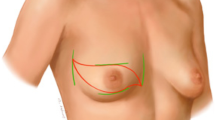Abstract
In obese patients following standard mastectomy for breast cancer, redundant skin persists at the lateral end of the mastectomy scar. It can be uncomfortable and unsightly. Moreover, uneven surface of skin fold especially in axilla increases the risk of radiation reaction. The standard transverse elliptical incision at the lateral end of mastectomy incision can be modified as a fish tail to avoid dog-ear deformity of the wound. This design of the incision enables the surgeon to mobilise the redundant skin employing the principle of ‘rotation advancement’ and close even large skin defects.



Similar content being viewed by others
References
Agrawal CS, Tiwari P, Mishra S, Rao A, Hadke NS, Adhikari S, Srivastava A (2014) Interrupted abdominal closure prevents burst: randomized controlled trial comparing interrupted-x and conventional continuous closures in surgical and gynecological patients. Indian J Surg 76(4):270–276
Stewart FT (1915) Amputation of the breast by a transverse incision. Ann Surg 62(2):250–251. https://doi.org/10.1097/00000658-191508000-00017
Hussien M, Daltrey IR, Dutta S, Goodwin A, Prance SE, Watkins RM (2004) Fish-tail plasty: a safe technique to improve cosmesis at the lateral end of mastectomy scars. Breast 2013:206–209
Al-Omishy H, Muttalib M, Sawyer O (2009) Non-bifid “fish-tail” plasty: a less cumbersome technique, to improve cosmesis at the lateral end of mastectomy scar. Eur J Surg Oncol 35(11):1230–1231
Mirza M, Sinha KS, Fortes-Mayer K (2003) Tear-drop incision for mastectomy to avoid dog-ear deformity. Ann R Coll Surg Engl 85:131
Nowacki MP, Towpik E, Tchorzewska H (1991) Early experience with fish-shaped incision for ma. Eur J Surg Oncol 17(6):615–617
Farrar WB, Fanning WJ (1988) Eliminating the dog-ear in modified radical mastectomy. Am J Surg 156:401–402
Goel V, Shukla S, Raju KV, Murtuza S, Rao TS (2019) Revisiting y-shaped closure technique to prevent the dog ear formation in women undergoing mastectomy. Indian J Surg Oncol 10(1):95–97
Lim GH, Tan HF (2016) Surgical techniques to avoid lateral dog ear of the mastectomy scar: a systematic review. Int J Surg 26:73–78
Author information
Authors and Affiliations
Corresponding author
Additional information
Publisher’s Note
Springer Nature remains neutral with regard to jurisdictional claims in published maps and institutional affiliations.
Rights and permissions
About this article
Cite this article
Ranjan, P., Meena, R., Puri, G. et al. FISH Mastectomy Incision: an Innovative AIIMS Technique. Indian J Surg 84 (Suppl 3), 799–802 (2022). https://doi.org/10.1007/s12262-020-02705-x
Received:
Accepted:
Published:
Issue Date:
DOI: https://doi.org/10.1007/s12262-020-02705-x




